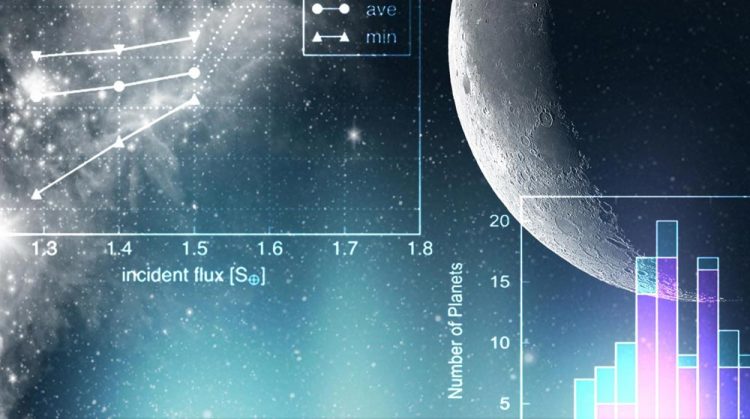15 new planets confirmed around cool dwarf stars

This is an imaginary picture. Credit: Tokyo Institute of Technology
Scientists report the existence of 15 new planets — including one 'super-Earth' that could harbor liquid water — orbiting small, cool stars near our solar system. These stars, known as red dwarfs[1], are of enormous interest for studies of planetary formation and evolution.
A research team led by Teruyuki Hirano of Tokyo Institute of Technology's Department of Earth and Planetary Sciences has validated 15 exoplanets[2] orbiting red dwarf systems.
One of the brightest red dwarfs, K2-155 that is around 200 light years away from Earth, has three transiting super-Earths, which are slightly bigger than our own planet. Of those three super-Earths, the outermost planet, K2-155d, with a radius 1.6 times that of Earth, could be within the host star's habitable zone[3].
The findings, published in the form of two papers in The Astronomical Journal, are based on data from NASA Kepler spacecraft's second mission, K2, and follow-up observations using ground-based telescopes, including the Subaru Telescope in Hawaii and the Nordic Optical Telescope (NOT) in Spain.
The researchers found that K2-155d could potentially have liquid water on its surface based on three-dimensional global climate simulations (see Figure 1). Hirano expresses both excitement and restraint, as he says: “In our simulations, the atmosphere and the composition of the planet were assumed to be Earth-like, and there's no guarantee that this is the case.”
A more precise estimate of the radius and temperature of the K2-155 star would be needed to conclude definitively whether K2-155d is habitable. Achieving such precision would require further studies, for example, using interferometric techniques.
A key outcome from the current studies was that planets orbiting red dwarfs may have remarkably similar characteristics to planets orbiting solar-type stars.
“It's important to note that the number of planets around red dwarfs is much smaller than the number around solar-type stars,” says Hirano. “Red dwarf systems, especially coolest red dwarfs, are just beginning to be investigated, so they are very exciting targets for future exoplanet research.”
For example, while the so-called radius gap[4] of planets around solar-type stars has been reported previously, this is the first time that researchers have shown a similar gap in planets around red dwarfs. (See Figure 2.) “This is a unique finding, and many theoretical astronomers are now investigating what causes this gap,” says Hirano.
He adds that the most likely explanation for the lack of large planets in the proximity of host stars is photoevaporation, which can strip away the envelope of the planetary atmosphere.
The researchers also investigated the relationship between planet radius and metallicity[5] of the host star. “Large planets are only discovered around metal-rich stars,” Hirano says, “and what we found was consistent with our predictions. The few planets with a radius about three times that of Earth were found orbiting the most metal-rich red dwarfs.”
The studies were conducted as part of the KESPRINT collaboration, a group formed by the merger of KEST (Kepler Exoplanet Science Team) and ESPRINT (Equipo de Seguimiento de Planetas Rocosos Intepretando sus Transitos) in 2016.
With the planned launch of NASA's Transiting Exoplanet Survey Satellite (TESS) in April 2018, Hirano is hopeful that even more planets will be discovered. “TESS is expected to find many candidate planets around bright stars closer to Earth,” he says. “This will greatly facilitate follow-up observations, including investigation of planetary atmospheres and determining the precise orbit of the planets.”
###
Technical terms
[1] Red dwarfs: Also known as low-mass stars, red dwarfs are small, cool stars with a surface temperature of less than about 4,000 Kelvin.
[2] Exoplanets: Planets that orbit stars outside our solar system.
[3] Habitable zone: A region that is neither too hot nor too cold for liquid water, and hence life, to exist.
[4] Radius gap: Here referring to a reduced occurrence of planets that have a radius of between 1.5 to 2.0 times that of Earth.
[5] Metallicity: The amount of metal found in a star.
Related links
https:/
http://www.
Media Contact
All latest news from the category: Physics and Astronomy
This area deals with the fundamental laws and building blocks of nature and how they interact, the properties and the behavior of matter, and research into space and time and their structures.
innovations-report provides in-depth reports and articles on subjects such as astrophysics, laser technologies, nuclear, quantum, particle and solid-state physics, nanotechnologies, planetary research and findings (Mars, Venus) and developments related to the Hubble Telescope.
Newest articles

NASA: Mystery of life’s handedness deepens
The mystery of why life uses molecules with specific orientations has deepened with a NASA-funded discovery that RNA — a key molecule thought to have potentially held the instructions for…

What are the effects of historic lithium mining on water quality?
Study reveals low levels of common contaminants but high levels of other elements in waters associated with an abandoned lithium mine. Lithium ore and mining waste from a historic lithium…

Quantum-inspired design boosts efficiency of heat-to-electricity conversion
Rice engineers take unconventional route to improving thermophotovoltaic systems. Researchers at Rice University have found a new way to improve a key element of thermophotovoltaic (TPV) systems, which convert heat…



